Simon Wins for Smoothness on SH-14
BY AsphaltPro Staff
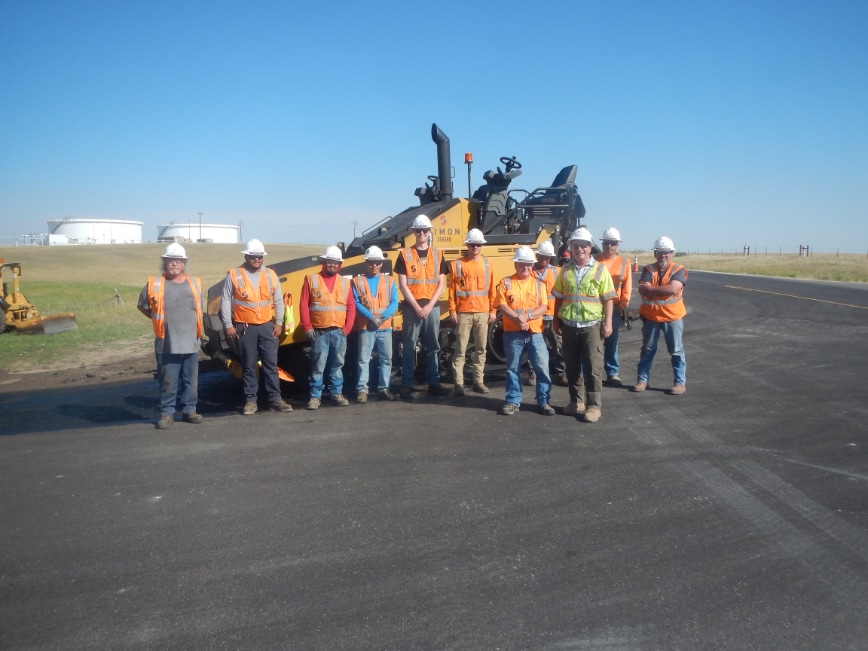
To win one of Colorado Asphalt Pavement Association’s “Best in Colorado” Asphalt Pavement Awards is already quite an honor, but imagine winning three awards for a single paving season.
That’s exactly what happened when Simon, a Colas company, Cheyenne, Wyoming, won awards in CAPA’s project innovation, smoothness (category II) and rural highway resurfacing categories. Furthermore, two of those awards were received for Simon’s performance on a single job on State Highway (SH) 14/New Raymer West in northeast Colorado. “It’s pretty rare for a project to get two awards, so we were extremely pleased,” said Simon Project Manager Kyle Rademacher.
Simon performs work in Wyoming, South Dakota, Nebraska and northeastern Colorado. Roughly 50 percent of its work is in Wyoming, and nearly 20 percent is in northeastern Colorado. The $5.5 million project on SH 14 consisted of full width milling to mitigate cracks, placement of 1-inch reflective crack interlayer (RCI) and 2.5-inch overlay.
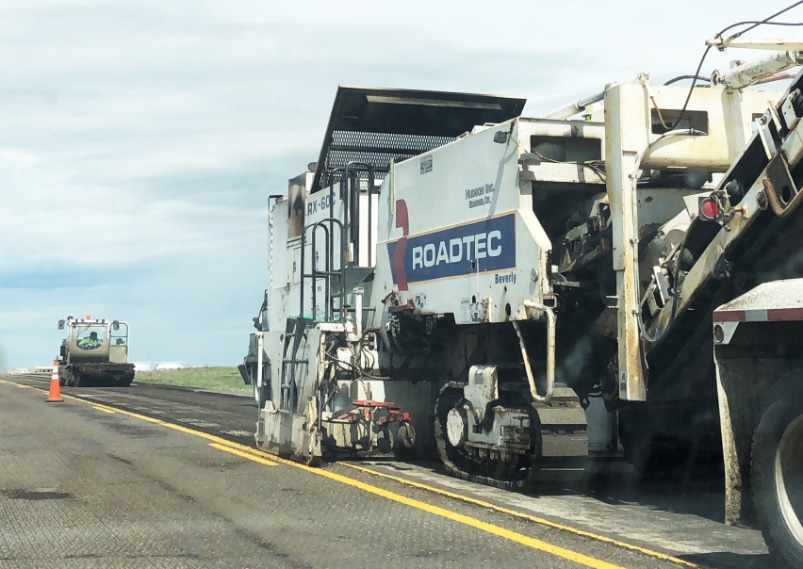
Hudson Incorporated milled off 1 inch of the existing roadway with its 12-foot Roadtec RX 60 C milling machine.
The project was located along 9.1 miles of SH 14, a two-lane state highway with an average annual daily traffic count of 2,100, nearly 40 percent of which is truck traffic as a result of nearby agriculture and oil production.
According to Rademacher, the existing roadway had large transverse cracks across the entire roadway and “entire sections of the roadway were deteriorating.” The agency, Colorado Department of Transportation (CDOT) Region 4, planned to use a high-AC RCI to combat the cracks.
“CDOT had done full-depth reclamation on an adjacent portion of SH 14, so this was a good opportunity to compare the two,” Rademacher said. CDOT Resident Engineer Jeff Dollerschell agreed with Rademacher’s assessment, adding “the existing pavement thickness was around 12 inches, and CDOT Region 4 was reluctant to grind it up.” Although CDOT Region 4 has used RCI on a few past projects, this was the first RCI project for CDOT Region 4’s Sterling Residency (one of six residencies in the region).

In total, Simon’s subcontractor, Hudson Incorporated, milled up 177,200 square yards of material, not including the patching sections.
Simon was awarded the job on SH 14 in February 2020, began work in May and finished in July, for a total of 51 working days.
Simon first milled the worst sections of the roadway, accounting for roughly 5 percent of the total project, to a depth between 4 and 5 inches and patched those areas. Then, Simon’s subcontractor, Hudson Incorporated, Edmond, Oklahoma, milled off 1 inch of the existing roadway with its 12-foot Roadtec RX 60 C milling machine.
In total Hudson milled up 177,200 square yards of material, not including the patching sections. Simon relies on Hudson to perform milling on many of the company’s jobs, both in Colorado and in Wyoming. “CDOT said this was one of the smoothest milling jobs they’ve seen in a while,” Rademacher said. “The subcontractor did a great job, and CDOT thought the same.”
For the 2.5-inch top lift on SH 14, Simon used 20 percent RAP from the project’s millings. “Recycling the asphalt taken off the road allowed us to be more innovative and to have a more competitive bid,” Rademacher said. “It also resulted in a good product for CDOT at a lower cost.”
Material from the patching portion of the project wasn’t used as RAP in the top lift, Rademacher said, “because we went down deeper in those patch areas, and we didn’t want to contaminate our RAP with different kinds of asphalt if the mix design changed in those 4 to 5 inches we were patching.”
The job required a total of 36,700 tons of asphalt: 11,200 tons for the RCI lift and 25,500 tons for the top lift. Fines from Simon’s quarry in Cheyenne, Wyoming, and sand and ⅜ minus crushed gravel from Simon’s pits in Sterling and Julesburg, Colorado, was trucked in for the job.
All mix for the job was produced with Simon’s brand new 400-ton-per-hour portable plant from Aesco Madsen, Auburn, Washington. “We purchased that plant in the winter of 2019, so this was the first job we got to do with it, which was really exciting,” Rademacher said. “It worked really well for us; that high-AC mix is a good one to break in a new plant on, since we couldn’t run terribly fast on the job. It was nice to test out the plant in a less fast-paced setting.”
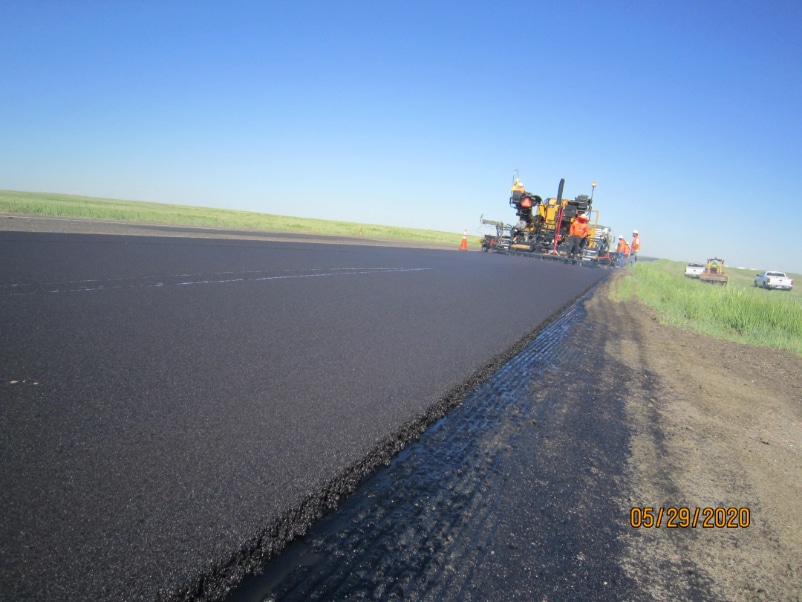
The job required a total of 36,700 tons of asphalt: 11,200 tons for the RCI lift and 25,500 tons for the top lift.
Simon was averaging 4 miles and 1,700 tons per day during the RCI portion of the project, running about 39 feet per minute. “A 1-inch lift stretches pretty far down the road,” Rademacher said. Furthermore, they had to ensure both traffic control and their rollers could keep up with their pace. When they paved the top lift, at 25 feet per minute, they were familiar with the new plant and were able to really see what it could do. “We got up to 400 tph a couple times on that job. Getting the new plant up and running was a huge task for [Asphalt Plant Foreman Timothy Klein] and his team, and they did a great job.”
Throughout the job, Simon controlled traffic on the two-lane highway with flaggers at the end of the 2- to 3-mile stretch they were working on, with a pilot car running between them. Simon sub-contracted traffic control to CC Enterprises, Grand Junction, Colorado. “They did a good job of picking up and moving with us,” Rademacher said. “We rely on them quite a bit; they do a good job.”
The company leased 10 acres of pasture from a farmer right in the middle of the job to set up its portable asphalt plant. The longest haul on the job was only 5 miles. “That was a huge advantage for us,” Rademacher said. “I imagine if the RCI sat in a truck for 30 or 40 miles, you might run into issues with it getting too stiff.”
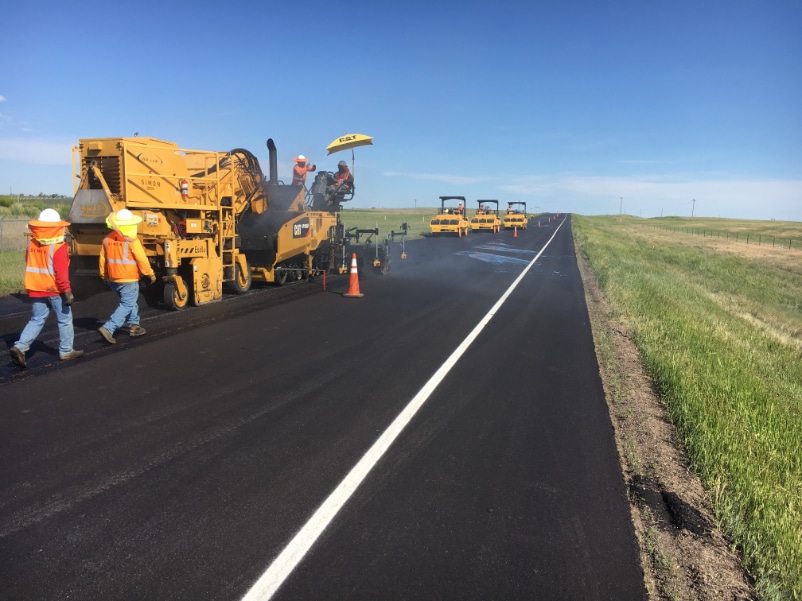
The crew paved both the RCI lift and top lift in two 18-foot passes with its Cat AP 1055 F paver and Weiler E650 C pickup machine.
The RCI mix utilized PG70-28 AC at 9 percent, 4 percent higher than normal asphalt designs Simon usually paves. Simon purchased the AC from Arkema-Road Science, Tulsa, Oklahoma, and had a representative from the company on-site to ensure the project’s success. Although Simon’s superintendent on the job had experience with RCI, SH 14 was Simon’s first RCI job. “We had a good idea of what to do and how to roll it, so we were very prepared,” Rademacher said, crediting both Arkema’s insight and the superintendent’s experience.
“The RCI mix was very fine and the AC content was so high that it almost looks like peanut butter as you’re laying it down,” Rademacher said, adding that this also contributed to the project’s overall smoothness. “RCI makes for a really nice smooth surface because it’s almost self-leveling.” The crew paved both the RCI lift and top lift in two 18-foot passes with its Cat AP 1055 F paver and Weiler E650 C pickup machine.
“After winning these awards, we’re looking forward to using RCI on another job,” Rademacher said.
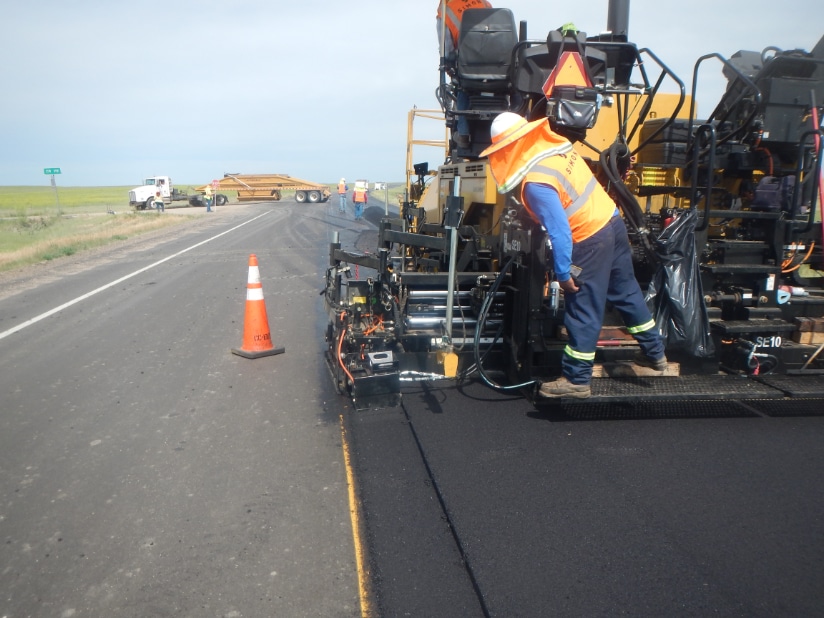
Simon was averaging 4 miles and 1,700 tons per day during the RCI portion of the project, running about 39 feet per minute.
Dollerschell said that they have no current plans for RCI projects, but added he would support its use. “The RCI has performed well so far,” Dollerschell said. “Time will tell the long-term durability of the RCI.”
One of the adjustments the Simon crew had to make when paving the RCI portion was ensuring their rollers were quick to begin compacting the mat. “Because the lift was so thin, it cooled down and stiffened up fast if we weren’t on top of it,” Rademacher said. Simon employed three steel drum rollers in tandem for the RCI lift.
For the top lift, Simon used two Sakai 990 steel drum rollers working in tandem for breakdown rolling and a finish roller to get final density and remove any roller marks. Simon achieved an average density of 94.2 on the project. They also achieved a final average MRI of 45.7 for the project, which resulted in Simon winning CAPA’s smoothness award (category II). Simon won the exact same category in CAPA’s 2018 awards. The company also won a Smoothest Pavement award in its home state, from the Wyoming Department of Transportation, in 2019 on Interstate 80.
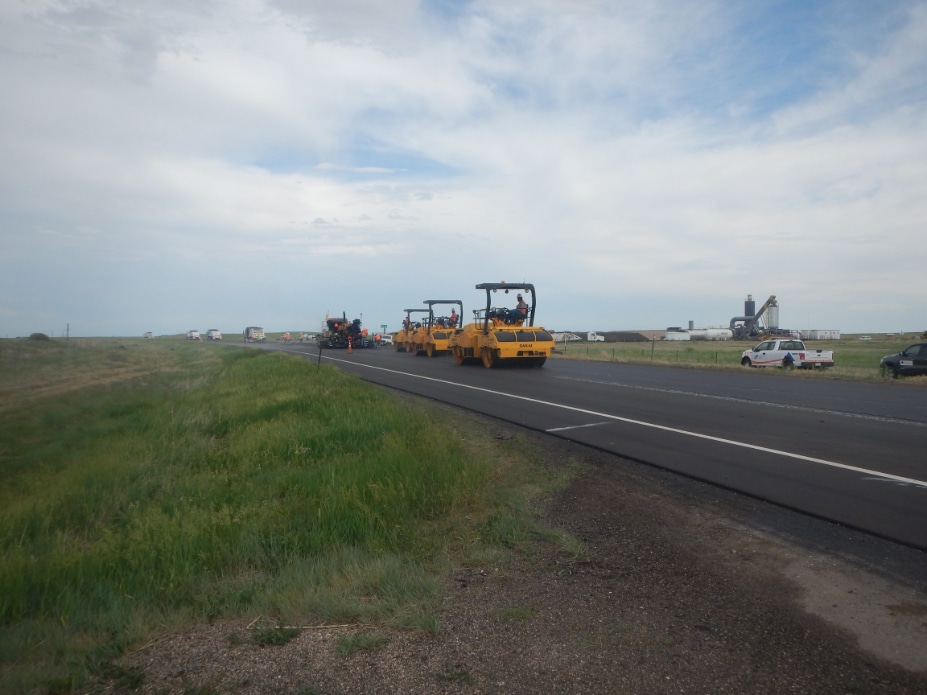
Simon achieved an average density of 94.2 on the project.
“Our guys are pretty good at winning those smoothness awards!” Rademacher said. “Smoothness is definitely something we take great pride in.” Simon’s pavers are equipped with grade control systems from Topcon Positioning Systems, Livermore, California. They also strive to keep the paver consistently full, pave at a consistent speed, and prevent rollers from stopping on the mat.
“Having a good milling subcontractor also helps,” Rademacher said. “That really determines how the rest of the road will ride. The quality of milling was an important part of achieving the smoothness award.”
Rademacher also praised key leaders that contributed to the project’s overall success. “Project Superintendent Lonnie Niesent brought experience with RCI, and that knowledge was invaluable on this project,” he said. “Foreman Albert Sisneros does a great job running his crew. The whole crew did an excellent job on their first RCI project because of his leadership.”

The project on SH 14 won multiple awards from Colorado Asphalt Pavement Association.
He also complimented CDOT Project Engineer Andrew Muller for returning test results quickly and being “a great partner throughout the whole process,” as well as CDOT’s consultant from RockSol, Thornton, Colorado, Roger Tanner, for exceptional coordination and communication. “The project would not have gone nearly as well without the team we had out there.”
From AC content and air voids to density and smoothness, Simon nearly maxed out CDOT’s incentive program on this job. “The quality of the job was so high that, on our last day, [Tanner] took a picture with the crew, congratulated them, and suggested we submit the job to CAPA’s awards program right away,” Rademacher said. Dollerschell added, “Simon and their subcontractors did a great job delivering a smooth, high-quality project.”
“These awards are a great feather in our cap,” Rademacher said. “We want to give people good roads for years to come. It’s nice to be appreciated for the work we do and receive that recognition.”
